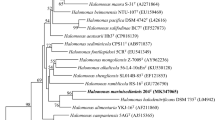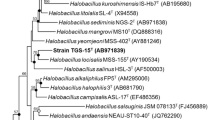Abstract
A novel Gram-positive, halotolerant, non-sporulating, non-motile, catalase-positive, oxidase-negative and aerobic bacterium, designated strain JSM 078085T, was isolated from sea water collected from the South China Sea. Strain JSM 078085T exhibited a rod-coccus growth cycle and produced a yellow pigment. The strain was able to grow in the presence of 0–12% (w/v) NaCl and at pH 6.0–9.5 and 4–35°C; optimum growth was observed at pH 7.0 and 25–30°C in the absence of NaCl. The peptidoglycan type was A4α (l-Lys–l-Ala–l-Glu). Cell-wall sugars contained galactose and glucose. Strain JSM 078085T contained menaquinone MK-9(H2) as the major respiratory quinone and diphosphatidylglycerol, phosphatidylglycerol and phosphatidylinositol as the major polar lipids. The major cellular fatty acids were anteiso-C15:0, iso-C15:0 and anteiso-C17:0 and the DNA G + C content was 63.3 mol%. Phylogenetic analysis based on 16S rRNA gene sequence comparisons revealed that strain JSM 078085T should be assigned to the genus Arthrobacter, being most closely related to the type strain of Arthrobacter rhombi (sequence similarity 97.1%), and the two strains formed a distinct lineage in the phylogenetic tree. The level of DNA–DNA relatedness between strain JSM 078085T and the type strain of Arthrobacter rhombi was 10.6%. The combination of phylogenetic analysis, DNA–DNA relatedness, phenotypic characteristics and chemotaxonomic data supported the view that strain JSM 078085T represents a novel species of the genus Arthrobacter, for which the name Arthrobacter halodurans sp. nov. is proposed. The type strain is JSM 078085T (=DSM 21081T=KCTC 19430T).

Similar content being viewed by others
References
Chen YG, Cui XL, Pukall R, Li HM, Yang YL, Xu LH, Wen ML, Peng Q, Jiang CL (2007) Salinicoccus kunmingensis sp. nov., a moderately halophilic bacterium isolated from a salt mine in Yunnan, south-west China. Int J Syst Evol Microbiol 57:2327–2332. doi:10.1099/ijs.0.64783-0
Chen YG, Zhang YQ, Huang K, Tang SK, Cao Y, Shi JX, Xiao HD, Cui XL, Li WJ (2009) Pigmentiphaga litoralis sp. nov., a facultatively anaerobic bacterium isolated from tidal flat sediment. Int J Syst Evol Microbiol 59:521–525. doi:10.1099/ijs.0.002949-0
Collins MD, Jones D (1980) Lipids in the classification and identification of coryneform bacteria containing peptidoglycans based on 2, 4-diaminobutyric acid. J Appl Bacteriol 48:459–470
Conn HJ, Dimmick I (1947) Soil bacteria similar in morphology to Mycobacterium and Corynebacterium. J Bacteriol 54:291–303
Cowan ST, Steel KJ (1965) Manual for the identification of medical bacteria. Cambridge University Press, London
Cui XL, Mao PH, Zeng M, Li WJ, Zhang LP, Xu LH, Jiang CL (2001) Streptomonospora salina gen. nov., sp. nov., a new member of the family Nocardiopsaceae. Int J Syst Evol Microbiol 51:357–363
Doetsch RN (1981) Determinative methods of light microscopy. In: Gerhardt P, Murray RGE, Costilow RN, Nester EW, Wood WA, Krieg NR, Phillips GH (eds) Manual of methods for general bacteriology. American Society for Microbiology, Washington, DC, pp 21–33
Ezaki T, Hashimoto Y, Yabuuchi E (1989) Fluorometric deoxyribonucleic acid-deoxyribonucleic acid hybridization in microdilution wells as an alternative to membrane filter hybridization in which radioisotopes are used to determine genetic relatedness among bacterial strains. Int J Syst Bacteriol 39:224–229
Felsenstein J (1985) Confidence limits on phylogenies: an approach using the bootstrap. Evolution 39:783–791. doi:10.2307/2408678
Felsenstein J (1997) An alternative least-squares approach to inferring phylogenies from pairwise distances. Syst Biol 46:101–111. doi:10.2307/2413638
Gregersen T (1978) Rapid method for distinction of gram-negative from gram-positive bacteria. Eur J Appl Microbiol Biotechnol 5:123–127. doi:10.1007/BF00498806
Groth I, Schumann P, Weiss N, Martin K, Rainey FA (1996) Agrococcus jenensis gen. nov., sp. nov., a new genus of actinomycetes with diaminobutyric acid in the cell wall. Int J Syst Bacteriol 46:234–239
Gupta P, Reddy GSN, Delille D, Shivaji S (2004) Arthrobacter gangotriensis sp. nov. and Arthrobacter kerguelensis sp. nov. from Antarctica. Int J Syst Evol Microbiol 54:2375–2378. doi:10.1099/ijs.0.63110-0
Hopwood DA, Bibb MJ, Chater KF, Kieser T, Bruton CJ, Kieser HM, Lydiate DJ, Smith CP, Ward JM (1985) Preparation of chromosomal, plasmid and phage DNA. In: Hopwood DA, Bibb MJ, Chater KF, Kieser T, Bruton CJ, Kieser HM, Lydiate DJ, Smith CP, Ward JM, Schrempf H (eds) Genetic manipulation of Streptomyces: a laboratory manual. F. Crowe and Sons, Norwich, pp 79–80
Jones D, Keddie RM (1992) The genus Arthrobacter. In: Balows A, Trüper HG, Dworkin M, Harder W, Schleifer KH (eds) The prokaryotes: a handbook on the biology of bacteria: ecophysiology, isolation, identification, applications, vol 2, 2nd edn. Springer, New York, pp 1283–1299
Kageyama A, Takahashi Y, Morisaki K, Omura S (2008) Arthrobacter oryzae sp. nov. and Arthrobacter humicola sp. nov. Int J Syst Evol Microbiol 58:53–56. doi:10.1099/ijs.0.64875-0
Keddie RM, Collins MD, Jones D (1986) Genus Arthrobacter Conn and Dimmick 1947, 300AL. In: Sneath PHA, Mair NS, Sharpe ME, Holt JG (eds) Bergey’s manual of systematic bacteriology, vol 2. Williams and Wilkins, Baltimore, pp 1288–1301
Kim KK, Lee KC, Oh HM, Kim MJ, Eom MK, Lee JS (2008) Arthrobacter defluvii sp. nov., 4-chlorophenoldegrading bacteria isolated from sewage. Int J Syst Evol Microbiol 58:1916–1921. doi:10.1099/ijs.0.65550-0
Kimura M (1980) A simple method for estimating evolutionary rates of base substitutions through comparative studies of nucleotide sequences. J Mol Evol 16:111–120. doi:10.1007/BF01731581
Kluge AG, Farris FS (1969) Quantitative phyletics and the evolution of anurans. Syst Zool 18:1–32. doi:10.2307/2412407
Koch C, Schumann P, Stackebrandt E (1995) Reclassification of Micrococcus agilis (Ali-Cohen 1889) to the genus Arthrobacter as Arthrobacter agilis comb. nov. and emendation of the genus Arthrobacter. Int J Syst Bacteriol 45:837–839
Margesin R, Schumann P, Spröer C, Gounot AM (2004) Arthrobacter psychrophenolicus sp. nov., isolated from an alpine ice cave. Int J Syst Evol Microbiol 54:2067–2072. doi:10.1099/ijs.0.63124-0
Mesbah M, Premachandran U, Whitman WB (1989) Precise measurement of the G + C content of deoxyribonucleic acid by high-performance liquid chromatography. Int J Syst Bacteriol 39:159–167
Minnikin DE, O’Donnell AG, Goodfellow M, Alderson G, Athalye M, Schaal A, Parlett JH (1984) An integrated procedure for the extraction of bacterial isoprenoid quinones and polar lipids. J Microbiol Methods 2:233–241. doi:10.1016/0167-7012(84)90018-6
Osorio CR, Barja JL, Hutson RA, Collins MD (1999) Arthrobacter rhombi sp. nov., isolated from Greenland halibut (Reinhardtius hippoglossoides). Int J Syst Bacteriol 49:1217–1220
Roh SW, Sung Y, Nam Y, Chang H, Kim K, Yoon J, Jeon CO, Oh H, Bae J (2008) Arthrobacter soli sp. nov., a novel bacterium isolated from wastewater reservoir sediment. J Microbiol 46:40–44. doi:10.1007/s12275-007-0239-8
Saitou N, Nei M (1987) The neighbor-joining method: a new method for reconstructing phylogenetic trees. Mol Biol Evol 4:406–425
Sasser M (1990) Identification of bacteria by gas chromatography of cellular fatty acids. MIDI Technical Note 101. MIDI Inc, Newark, DE
Schleifer KH, Kandler O (1972) Peptidoglycan types of bacterial cell walls and their taxonomic implications. Bacteriol Rev 36:407–477
Smibert RM, Krieg NR (1994) Phenotypic characterization. In: Gerhardt P, Murray RGE, Wood WA, Krieg NR (eds) Methods for general and molecular bacteriology. American Society for Microbiology, Washington, DC, pp 607–654
Stackebrandt E, Ebers J (2006) Taxonomic parameters revisited: tarnished gold standard. Microbiol Today 33:152–155
Stackebrandt E, Fowler VJ, Fiedler F, Seiler H (1983) Taxonomic studies on Arthrobacter nicotianae and related taxa: description of Arthrobacter uratoxydans sp. nov. and Arthrobacter sulfureus sp. nov. and reclassification of Brevibacterium protophormiae as Arthrobacter protophormiae comb. nov. Syst Appl Microbiol 4:470–486
Staneck JL, Roberts GD (1974) Simplified approach to identification of aerobic actinomycetes by thin-layer chromatography. Appl Microbiol 28:226–231
Tamura K, Dudley J, Nei M, Kumar S (2007) MEGA4: molecular evolutionary genetic analysis (MEGA) software version 4.0. Mol Biol Evol 24:1596–1599. doi:10.1093/molbev/msm092
Thompson JD, Gibson TJ, Plewniak F, Jeanmougin F, Higgins DG (1997) The CLUSTAL_X windows interface: flexible strategies for multiple sequence alignment aided by quality analysis tools. Nucleic Acids Res 25:4876–4882. doi:10.1093/nar/25.24.4876
Wayne LG, Brenner DJ, Colwell RR, Grimont PAD, Kandler O, Krichevsky MI, Moore LH, Moore WEC, Murray RGE et al (1987) International committee on systematic bacteriology. Report of the ad hoc committee on reconciliation of approaches to bacterial systematics. Int J Syst Bacteriol 37:463–464
Xiao HD, Chen YG, Liu ZX, Huang K, Li WJ, Cui XL, Zhang L, Yi LB (2009) Phylogenetic diversity of cultivable bacteria associated with a sea anemone from coast of the Naozhou island in Zhanjiang, China. Acta Microbiol Sin 49:246–250
Acknowledgments
This work was supported by grants from the National Natural Science Foundation of China (NSFC) (30860013, 30860002, 30660004), Jishou University (jsdxkyzz200811), the Ministry of Science and Technology, PR China (2006BAE01A01-9, 863 Program, no. 2007AA021306), Key Projects of International Cooperation (2007DFB31620), the Yunnan Provincial Sciences and Technology Department (2005PY01-1, 2006C0006 M) and Yunnan University (2008YB005). We are grateful to Mr. Huai-Dong Xiao and Mr. Ke Huang for their excellent technical assistance.
Author information
Authors and Affiliations
Corresponding author
Additional information
The GenBank/EMBL/DDBJ accession number for the 16S rRNA gene sequence of strain JSM 078085T is EU583729.
Rights and permissions
About this article
Cite this article
Chen, YG., Tang, SK., Zhang, YQ. et al. Arthrobacter halodurans sp. nov., a new halotolerant bacterium isolated from sea water. Antonie van Leeuwenhoek 96, 63–70 (2009). https://doi.org/10.1007/s10482-009-9336-5
Received:
Accepted:
Published:
Issue Date:
DOI: https://doi.org/10.1007/s10482-009-9336-5




